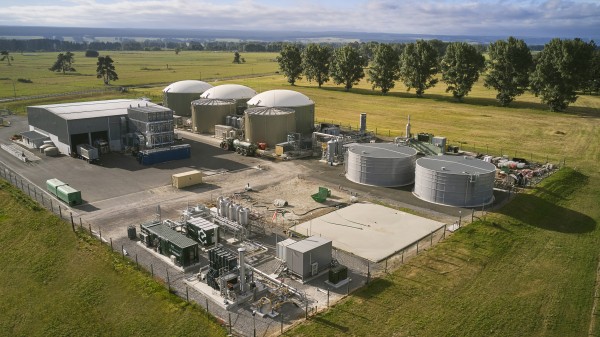Biogas is a renewable energy source that comes from organic waste. Almost any organic waste product, from food scraps to crops to human sewage, can be turned into biogas. It doesn’t create any additional greenhouse gas emissions, making it a net zero emissions gas.
By turning waste into gas, we get rid of an unwanted product and create a useful resource, so biogas contributes to a more circular economy. Here in New Zealand we have just started to tap the potential of biogas. We generate biogas on farms, at wastewater treatment facilities, and from household food waste at the Ecogas plant in Reporoa. Our First Renewables plant turns the Reporoa biogas into biomethane, which we then blend into the Firstgas pipeline, helping to lower carbon emissions across our gas network.
But that’s just the tip of the iceberg. While biogas and biomethane currently only provide 1% of the global energy supply, demand is predicted to triple by 2030. Let’s take a look at how the world is embracing biogas, from Europe to the USA, India and Oceania.

First Renewables biomethane upgrade facility
The European Union leads the way
The EU is the world leader in biogas and biomethane production, with over 1,500 biomethane plants installed across Europe. Together these prevent nearly 29 million tonnes of carbon dioxide emissions annually, and produce around 830,000 tonnes of organic fertiliser. In 2024, EU biomethane capacity grew by 37%.
Turning cow waste into affordable energy in India
Indian cattle produce three million tonnes of dung each day, and it’s increasingly being turned into biogas by local people. The process not only cleans up the dung, but also improves energy security for the nation, makes energy cheaper for rural people, and produces valuable fertiliser.
US biogas investment up 40%
Investment in biogas projects grew by 40% in 2024, a new record, with 125 new projects coming online during the year, bringing the total number of facilities to just under 2,500. Biogas from landfills is often converted to electricity, while agricultural projects produce more biomethane.
New biogas projects are happening across the USA, with forecast projects creating hundreds of thousands of construction jobs and tens of thousands of permanent jobs.
South Korea recycles 98% of food waste
Since 2005, South Korea has had a ban on putting food waste into landfills – instead, its 50 million citizens separate out their food waste and send it for recycling. People are charged for how much waste they produce. The result has been impressive, with less food waste overall, and 98% of food waste recycled. The food waste is turned into compost, animal feed and biogas.

Source: iStock image used for illustrative purposes only.
Brazil has 32 biomethane projects in the pipeline
Brazil is rapidly adopting renewable gas technology to help it deal with waste and reduce its carbon emissions. The nation has 32 biomethane projects awaiting a green light, adding to its 10 existing biomethane facilities. One driver of demand is the transport industry, where trucks are switching from diesel to biomethane.
Australia predicts a tripling in biomethane demand in five years
Closer to home, Australian demand for biomethane is predicted to rise rapidly, driven by large industrial customers, according to a 2025 EY report. The biogas sector has the potential to add $10 billion a year to the Australian economy and create over 26,000 jobs.
A new food waste plant in Christchurch
Here in New Zealand, a new Ecogas food scrap facility in Christchurch has been approved. Located at a South Hornby industrial site, the plan is for the plant to be accepting organic waste from late 2026.
You can read more about renewable gas in our pipelines here, and to learn about how Clarus is supporting the transition to a net carbon neutral New Zealand, visit Future of Energy.

